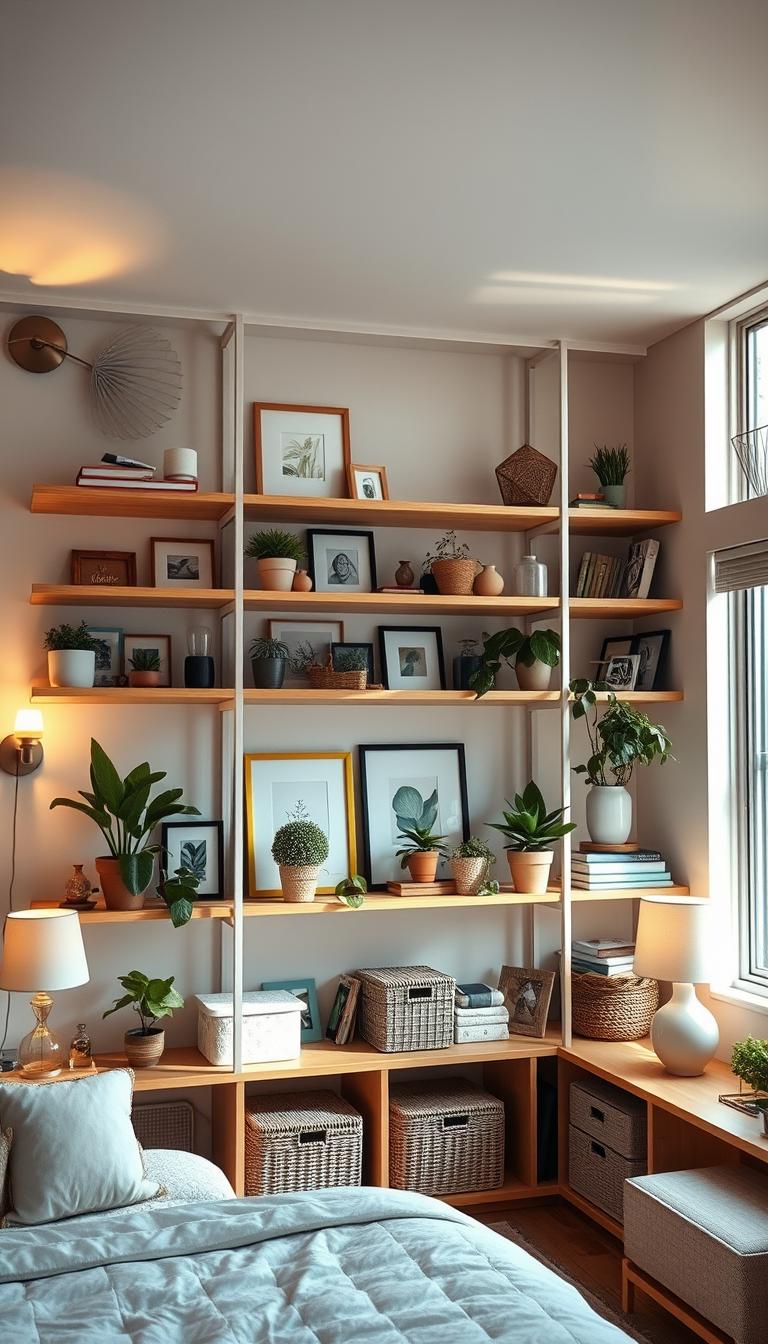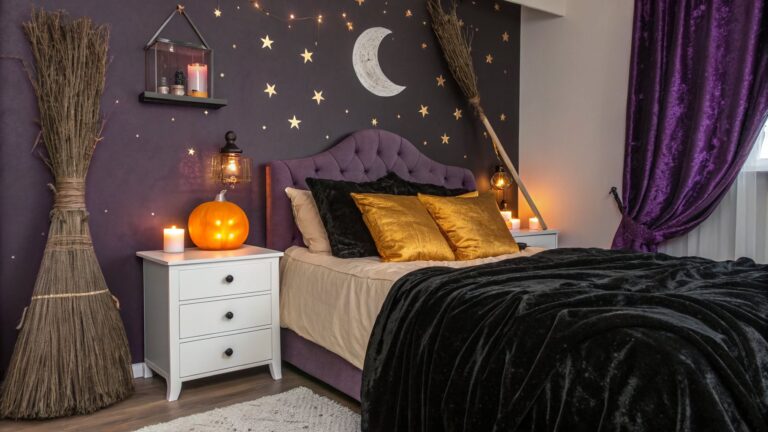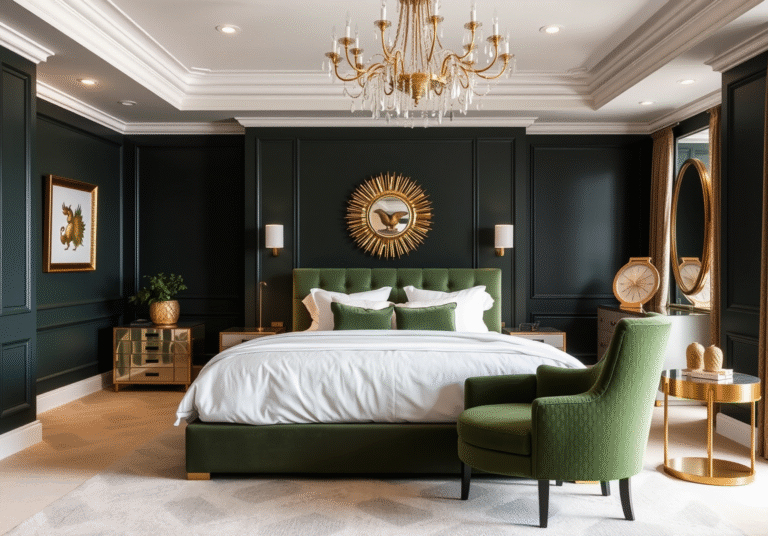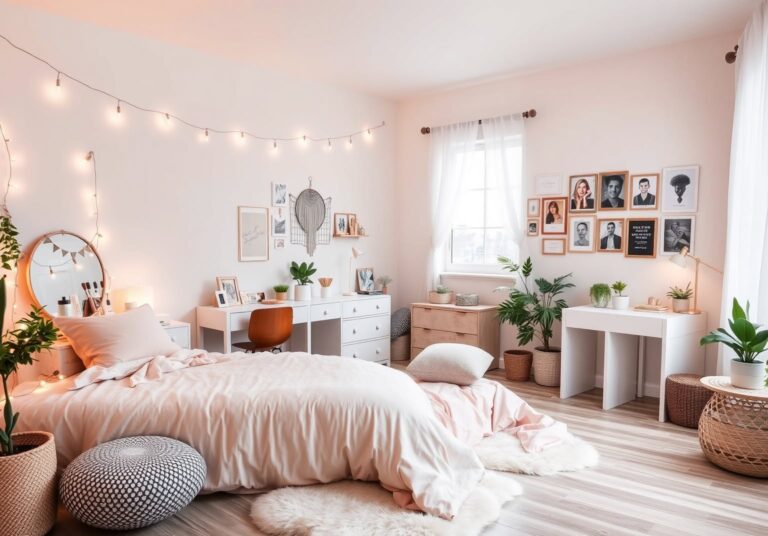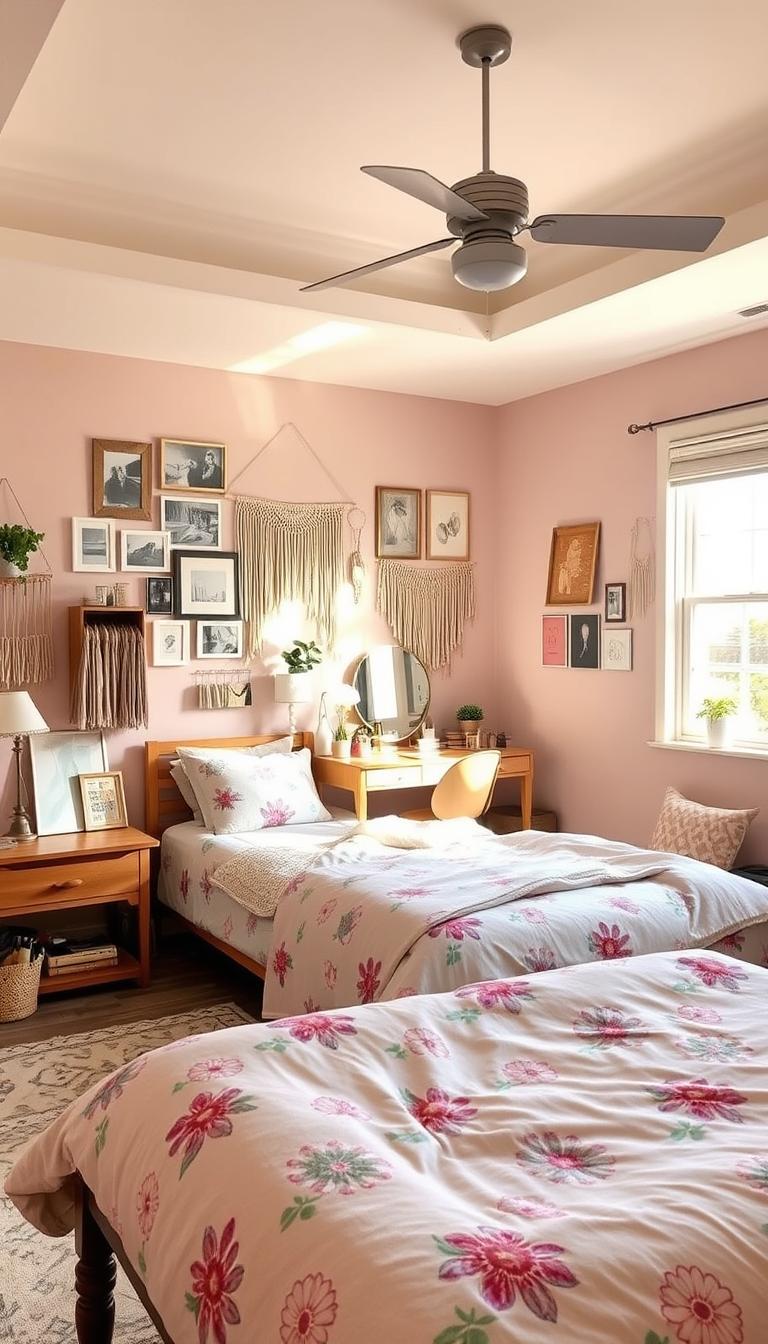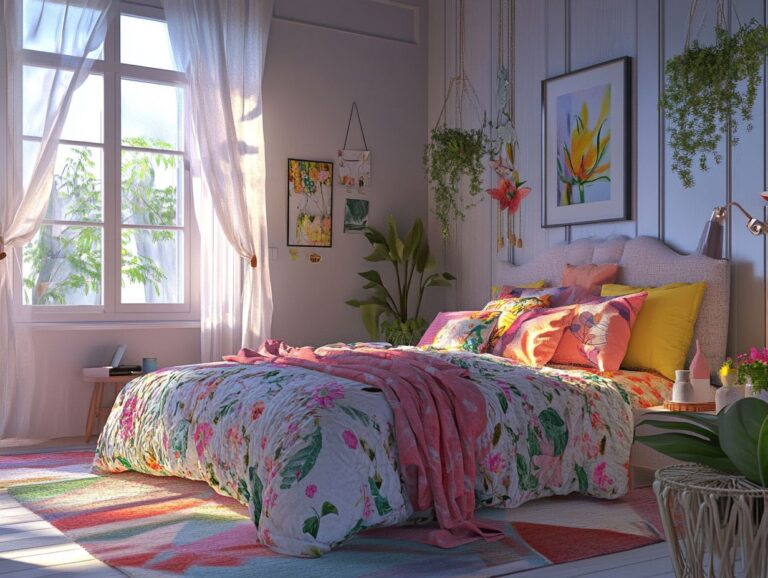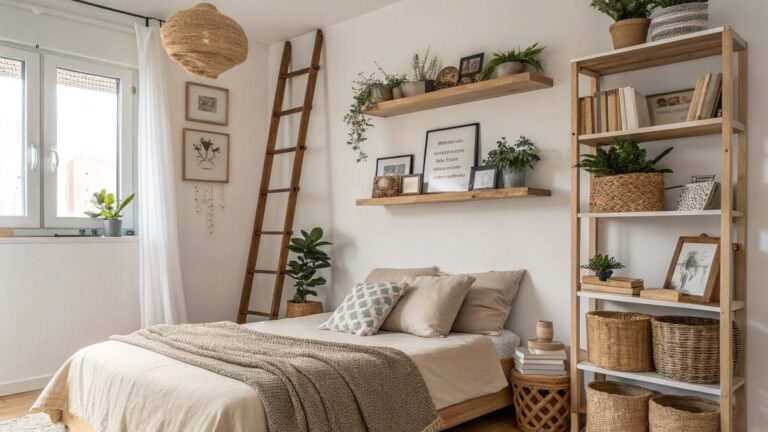Bedroom Shelving Ideas to Optimize Your Bedroom Storage
Is your sleeping space feeling cramped or cluttered? Clever shelving setups can turn chaos into calm while adding personality to your room. Whether you’re working with tight corners or blank walls, strategic storage solutions blend practicality with aesthetics.
Designers like Cate St Hill and Brittany Viklund showcase how custom-cut wooden shelves transform underused areas. For example, floating units in alcoves create display zones for books, plants, or treasured decor. These setups maximize vertical space without overwhelming smaller rooms.
Shelving isn’t just about tidiness—it’s a chance to elevate your home’s style. Think of open racks as frames for curated collections or layered ledges that guide the eye upward. Materials like warm oak or sleek metal adapt to modern, rustic, or minimalist themes.
Ready to reimagine your space? Focus on layouts that balance function and visual flow. Even simple DIY projects can turn basic storage into a striking design element. Let’s explore how smart organization meets creativity!
Introduction to Creative Bedroom Shelving
Empty walls and corners hold untapped potential for smart, stylish organization. Modern storage solutions turn overlooked room areas into functional displays. Floating units, for example, add depth to plain surfaces while keeping floors clear.
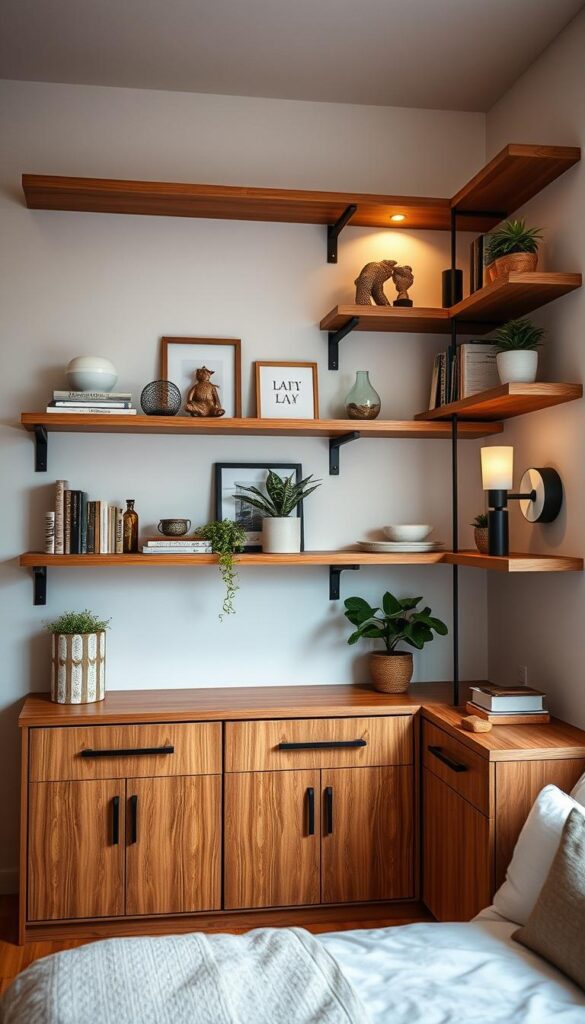
These setups do more than store items—they become part of your decor. A shelf near the bed can double as a nightstand, holding lamps and favorite books. Corners might host triangular units that fit snugly, perfect for plants or framed photos.
Multi-level designs create zones for different needs. Lower tiers might hold daily essentials like journals or skincare products. Higher ones showcase art pieces or travel souvenirs. One bold example? Rainbow-organized shelves above a reading nook blend color therapy with practicality.
| Shelving Style | Best Use | Space Impact |
|---|---|---|
| Floating Ledges | Displaying Books/Decor | Vertical Efficiency |
| Corner Units | Compact Storage | Awkward Area Fix |
| Desk-Integrated | Work + Storage | Dual Functionality |
Ready to rethink your space? The following sections break down how to match these solutions to your style and needs. From DIY hacks to material choices, every idea prioritizes both form and function.
Maximizing Wall Space with Floating Shelves
Vertical surfaces offer a golden opportunity to blend storage with self-expression. Floating shelves act as minimalist heroes—sturdy enough for practical use yet sleek enough to showcase personality. Their hidden brackets create a “hovering” effect that makes rooms feel airier.
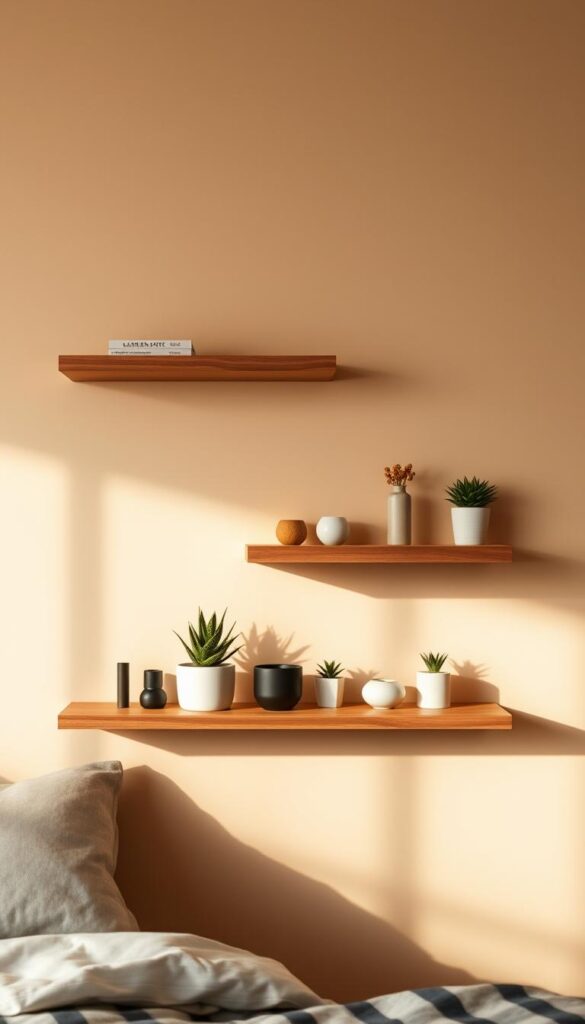
Installation starts with finding wall studs or using heavy-duty anchors. For example, a 24-inch shelf holding books needs at least two mounting points. Use a level to ensure straight lines—crooked units distract from their clean look.
Curate your displays like a gallery wall. Layer small plants beside stacked novels or place ceramic vases at varying depths. Odd-numbered groupings (3 or 5 items) create balanced asymmetry. Leave 30% empty space to avoid visual clutter.
| Shelf Type | Ideal Purpose | Weight Capacity |
|---|---|---|
| Modular Grids | Modular Grids | Modular Grids |
| Corner Floating | Compact Zones | 15-20 lbs |
| Industrial Pipe | Heavy Items | 50+ lbs |
Mix depths and lengths for rhythm. Try a 36-inch shelf above a desk flanked by 12-inch ledges. This combo provides workspace for a lamp and frames photos without crowding. Test layouts with painter’s tape before drilling.
Always check weight limits—decorative trays weigh less than hardcover collections. Pair thicker shelves with metal brackets for extra support. Smart placement turns forgotten walls into functional art.
Unique Shelving Designs for Every Bedroom Style
Match your room’s vibe with storage that speaks your design language. From industrial pipe frames to curved wooden units, shelving adapts to any aesthetic. Modern spaces thrive with geometric metal grids, while rustic themes shine with reclaimed barnwood ledges.
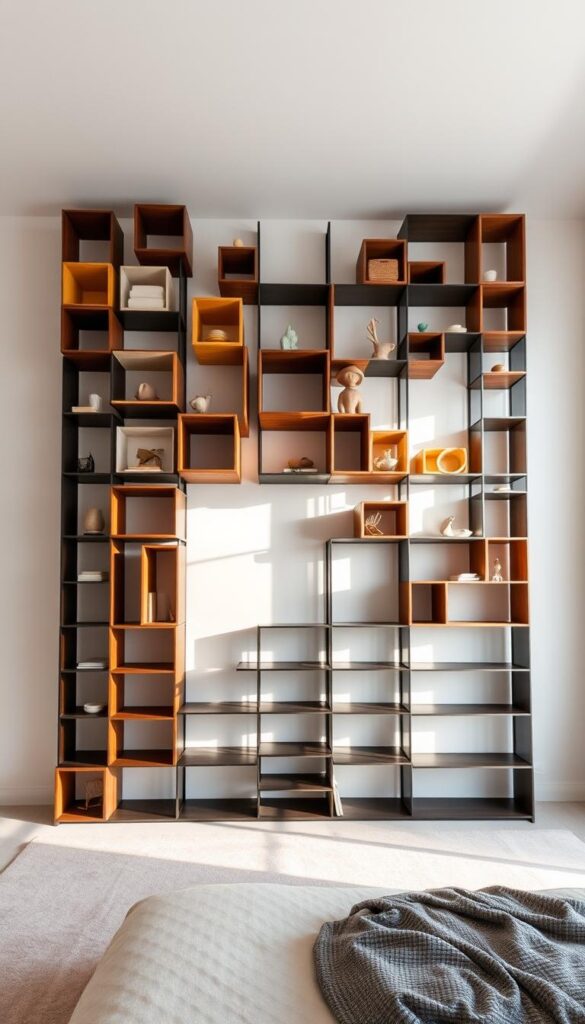
Think beyond basic placement. Install staggered tiers above your bed frame for nighttime essentials and framed art. Corner ladder shelves add vertical interest without crowding walkways. For tiny spaces, try fold-down units that tuck away when not in use.
Color and finish matter. Soft pastel shelves blend into serene Scandinavian spaces, while glossy black racks pop against neutral walls. Pair warm walnut with brass hardware for transitional decor, or go bold with lacquered red shelves in eclectic setups.
| Style | Material Pairing | Design Tip |
|---|---|---|
| Mid-Century | Teak + Hairpin Legs | Use asymmetrical spacing |
| Farmhouse | Distressed Pine + Iron | Add woven baskets |
| Art Deco | Mirrored Glass + Chrome | Display geometric decor |
Mix materials to create depth. Try floating glass panels beside chunky wood blocks, or combine metal grid panels with marble accents. Vary shelf depths—12-inch ledges hold plants, while 6-inch strips showcase small sculptures.
Play with layouts to reflect your personality. Cluster three narrow shelves near seating areas for books and throws. Go floor-to-ceiling in unused alcoves for a library feel. Your storage should feel like an extension of your style, not just practical add-ons.
DIY Solutions and Custom Shelf Designs
Unleash your inner carpenter with projects that transform basic materials into storage masterpieces. Custom builds let you control every detail—from exact measurements to finish choices—ensuring perfect harmony with your room’s layout. Start by sketching your vision, then gather affordable supplies like plywood, metal brackets, or salvaged lumber.
Measure twice, cut once. Use a tape measure to map available floor space and furniture dimensions. For example, build shallow shelves above a desk to hold supplies without blocking workspace. Sand edges smooth, then stain or paint to match your decor. Upcycle old cabinets by removing doors and adding fresh hardware for open displays.
Consider these material options:
| Material | Project Difficulty | Best Use |
|---|---|---|
| Reclaimed Wood | Intermediate | Rustic wall units |
| Metal Pipes | Advanced | Industrial corner racks |
| Plywood | Beginner | Floating ledges |
Safety first—secure heavy shelves to wall studs using angled brackets. Test weight limits with books before adding delicate items. For quirky charm, arrange mismatched crates in staggered heights. Custom designs solve unique challenges while reflecting your personality. Grab a drill and let creativity guide your next build!
Functional & Stylish Uses for Shelves in the Bedroom
Transform ordinary ledges into multitasking heroes that tackle storage needs while elevating your room’s aesthetic. Clever arrangements replace bulky furniture, freeing up floor space for movement or larger decor pieces. A floating unit beside your bed, for instance, can moonlight as a compact nightstand.
Swap traditional bedside tables with sturdy shelves that hold lamps, reading materials, and personal items. Install them at arm’s reach from your mattress—ideal for midnight water bottles or charging devices. Pair with woven baskets underneath for hidden storage of extra blankets or electronics.
Wall-mounted setups also create compact work zones. A 24-inch shelf above a small stool becomes a laptop station or charging hub. Add a power strip underneath for tidy cable management. This approach turns unused wall areas into productive spots without requiring a full desk.
| Shelf Function | Practical Use | Styling Tip |
|---|---|---|
| Bedside Replacement | Holds lamps, books, alarms | Add slim tray for jewelry |
| Mini Workstation | Supports laptop, notebooks | Use corkboard backdrop |
| Display Hub | Shows plants, framed photos | Layer heights for depth |
Decorative displays merge organization with personality. Curate shelves with trailing pothos plants beside favorite novels or ceramic vases. Leave breathing room between objects—crowded surfaces feel chaotic rather than intentional.
Balance function and style by choosing finishes that complement your bedding or rug. Matte black shelves ground airy spaces, while oak tones warm up minimalist setups. Smart dual-purpose designs keep essentials handy without sacrificing visual harmony.
bedroom shelving ideas
Transform overlooked nooks into functional displays with smart layouts. Clever shelf arrangements breathe life into tight spaces while boosting storage capacity. Let’s explore layouts that blend practicality with visual appeal.
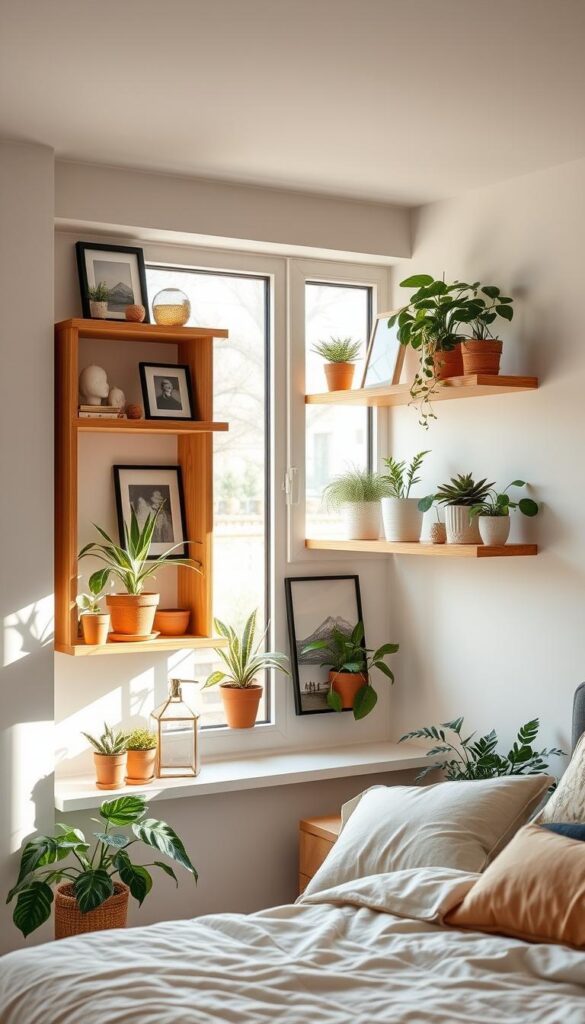
Window-adjacent setups harness natural light for plant displays or reading corners. Install shallow ledges beneath sills to hold succulents or candles. Pair with sheer curtains to soften sunlight while keeping items visible.
Define zones in compact areas using vertical units. A trio of narrow shelves beside an armchair creates a mini library for books and mugs. Leave one ledge empty for temporary storage like folded blankets or current reads.
| Placement | Function | Styling Tip |
|---|---|---|
| Above Doorways | Rarely-used decor storage | Use uniform baskets |
| Bed Alcoves | Nightstand alternative | Add touch lamp |
| Room Dividers | Privacy screen + storage | Alternate open/closed units |
Floating shelves over radiators or vents utilize tricky areas. Choose heat-resistant materials like metal or treated wood. Style with lightweight items like framed prints or air plants.
Even basic designs make impacts. A single reclaimed wood ledge above a desk holds daily essentials while adding texture. Rotate decor seasonally—stack beach stones in summer, pinecones in winter.
Remember: Leave 40% negative space on each shelf. This prevents clutter and lets favorite items shine. Your storage solutions should feel intentional, not overcrowded.
Multi-Purpose Shelving for Home Offices and Nurseries
Versatile storage solutions adapt effortlessly to changing needs across your living spaces. A single shelving system can transition from a professional workspace to a playful kids’ zone while maintaining style and order. This flexibility proves especially useful in homes where rooms serve multiple purposes.
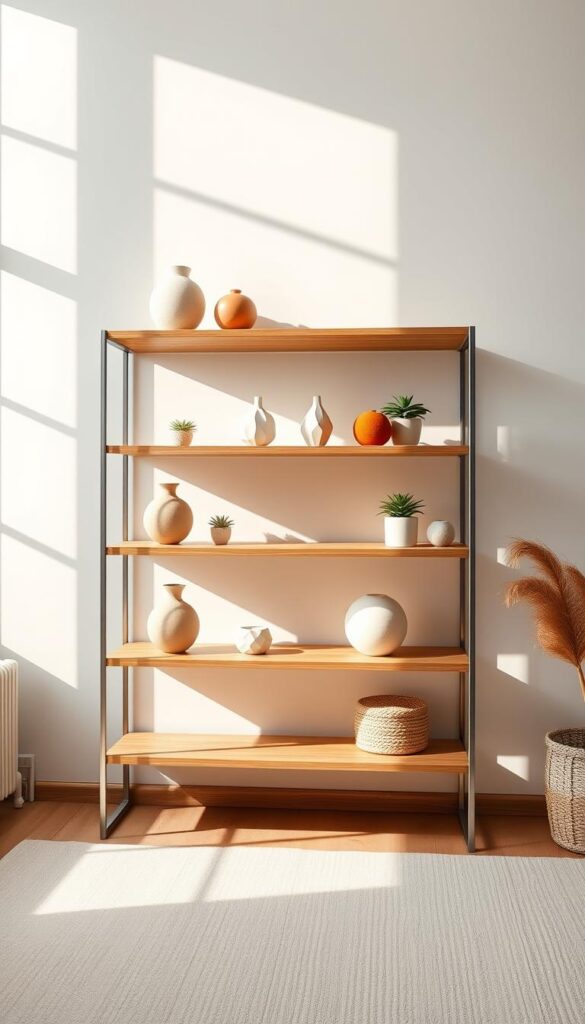
In home offices, floating units above desks keep supplies within reach without cluttering work surfaces. Pair a 24-inch shelf with drawer organizers for pens, sticky notes, and charging cables. Add a small potted plant or framed photo to soften the functional setup.
Nurseries benefit from sturdy, rounded-edge designs that safely store toys and books. Mount lower shelves at toddler height for easy access to stuffed animals or building blocks. Higher tiers display whimsical decor like mobiles or growth charts.
| Room Type | Shelving Function | Styling Tip |
|---|---|---|
| Home Office | Document organization | Use matching file boxes |
| Nursery | Toy rotation system | Add colorful bins |
| Transitional Spaces | Dual-purpose storage | Mix office and decor items |
Choose neutral finishes like white oak or matte black for seamless room transitions. These tones complement both adult workspaces and children’s areas. Adjustable height options accommodate evolving needs as kids grow or work requirements change.
In smaller houses, this approach creates visual consistency between rooms. A matching shelving unit in a compact office-nursery combo keeps the space unified. Rotate displayed items seasonally to keep the setup fresh and functional.
Incorporating Plants and Artwork on Your Shelves
Turn functional ledges into living galleries by blending greenery with personal treasures. Strategic placement of plants and art transforms storage areas into dynamic focal points. Start with low-maintenance varieties like snake plants or pothos that thrive in indirect light—perfect for spaces near windows or lamps.
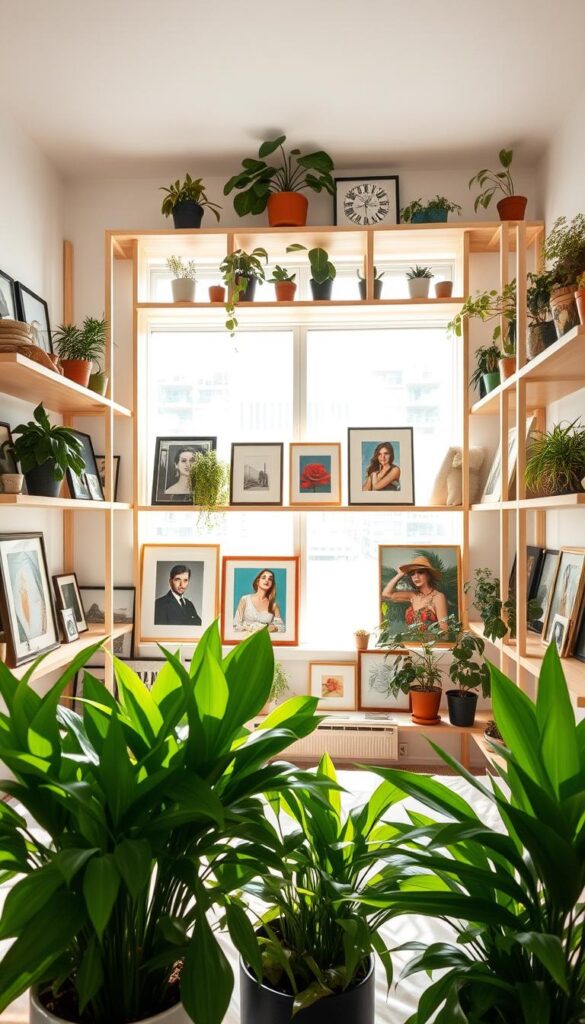
Layer textures and heights for visual interest. Place trailing ivies beside vertical framed prints, or stack hardcover novels under petite succulents. Use odd-number groupings (3-5 items) to create rhythm. Leave breathing room between objects—40% empty space prevents clutter while highlighting key pieces.
| Plant Type | Light Needs | Art Pairing Idea |
|---|---|---|
| Snake Plant | Low light | Black-and-white photography |
| Pothos | Medium light | Abstract watercolors |
| Air Plants | Bright light | Geometric sculptures |
Coordinate colors for cohesion. Match ceramic pots to artwork tones, or let vibrant planters contrast neutral walls. In sleeping areas, position fragrant lavender near bedside shelves to promote relaxation. Rotate seasonal decor—swap autumn leaves for spring blooms to keep displays fresh.
Mix functional and decorative elements. A stack of favorite books anchors one side, while a sculptural vase balances the other. Add depth with leaning art pieces or framed family photos. Your shelves become storytelling surfaces that evolve with your style.
Choosing Materials and Finishes for a Cohesive Look
Selecting materials that complement your decor creates harmony between storage and style. Durable hardwoods like oak withstand heavy books, while tempered glass adds airy lightness to compact areas. Match finishes to your room’s palette—warm walnut stains enhance cozy neutrals, and matte black pairs with modern accents.
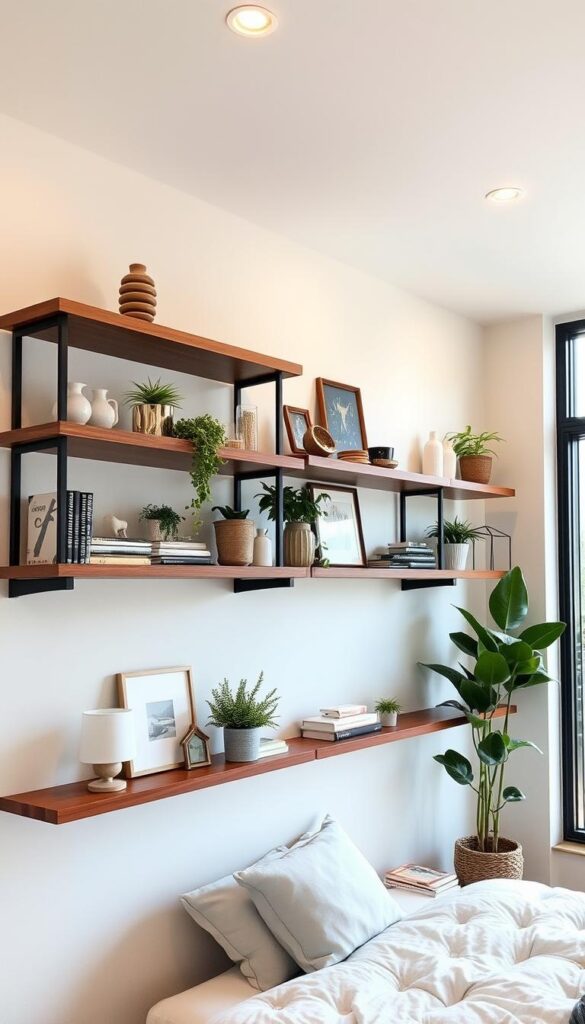
Consider maintenance needs. Glossy surfaces show fingerprints but reflect light in dim spaces. Textured laminates hide dust, ideal for high-traffic zones. For DIY projects, pre-finished plywood saves time and ensures color consistency with existing furniture.
| Material | Finish Options | Best For |
|---|---|---|
| Hardwood | Natural stain, whitewash | Traditional or rustic styles |
| Glass | Clear, frosted | Modern minimalist spaces |
| Laminate | Matte, woodgrain | High-humidity areas |
| Metal | Brushed, powder-coated | Industrial or eclectic themes |
Hardware choices matter. Concealed brackets maintain sleek lines, while decorative knobs add personality. In a small bedroom, brass handles can echo lighting fixtures for visual continuity. Always test stain samples against your wall color under natural and artificial light.
Balance durability with design. A walnut shelf with brass brackets becomes a focal point in neutral rooms. White laminate units make tight spaces feel larger. Your selections should solve storage needs while blending seamlessly into your overall aesthetic.
Planning and Measuring for Optimal Storage Space
Struggling to balance style and practicality? Smart planning turns awkward nooks into organized displays. Start by measuring your wall area with a tape measure—note electrical outlets, vents, and furniture placement. This prevents “shelf regret” later.
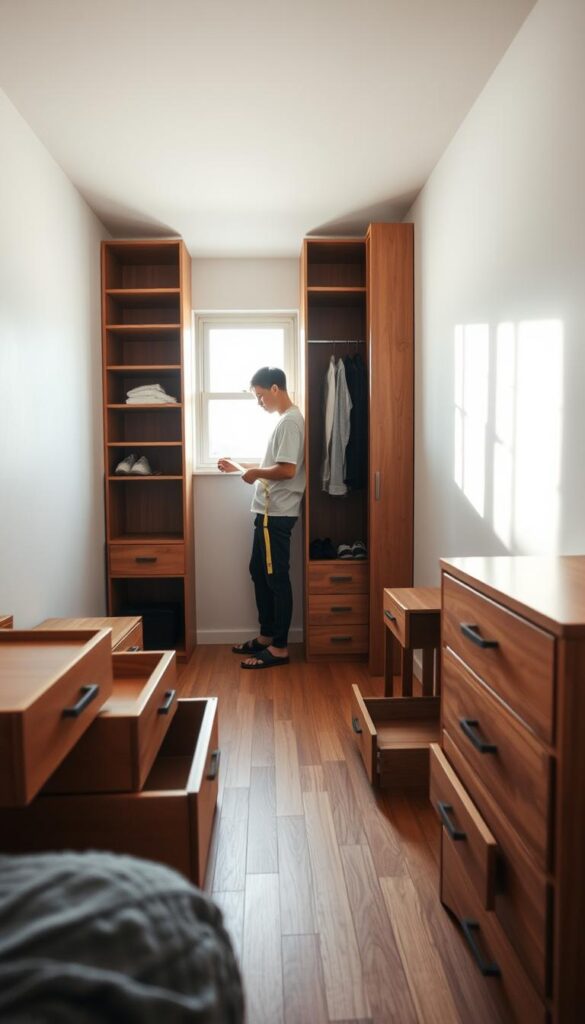
Depth matters. Allow 10-12 inches for hardcover books, but keep decor displays at 6-8 inches to avoid clutter. Use painter’s tape to mock layouts before drilling. For tight spaces, vertical spacing between shelves should be 12-15 inches—enough for tall vases or stacked novels.
| Shelf Use | Ideal Depth | Spacing | Weight Limit |
|---|---|---|---|
| Books | 10-12″ | 12″ vertical | 30 lbs |
| Decor | 6-8″ | 15″ vertical | 15 lbs |
| Plants | 8-10″ | 18″ vertical | 20 lbs |
Check weight limits with a stud finder. Drywall anchors hold 20-50 lbs, but wall studs support heavier loads. In one apartment makeover, floating shelves above a radiator held air plants and framed art—saving floor space while adding warmth.
Leave breathing room. Fill only 60% of each shelf’s surface. This keeps essentials accessible without visual chaos. Rotate seasonal items like holiday decor or beach reads to maintain freshness.
Smart measurements create storage that works as hard as you do. With careful planning, even narrow walls become functional displays that elevate your room’s design.
Conclusion
Revolutionize your room’s layout with clever storage solutions that marry form and function. Throughout this guide, we’ve explored how floating units maximize vertical areas, DIY projects add custom flair, and material choices elevate decor. These strategies prove that smart organization can coexist with self-expression.
Your sleeping quarters become extensions of your personality through thoughtful design choices. Whether replacing a bedside table with wall-mounted ledges or framing a desk with geometric shelves, every adjustment tells your story. Don’t hesitate to mix materials—warm wood alongside industrial metal creates captivating contrasts.
Remember: successful installations start with precise measurements and bold experimentation. Sketch your vision, test layouts with painter’s tape, and prioritize pieces that spark joy. Even minor changes, like adding a narrow shelf above doorways, yield major impacts.
Now armed with inspiration and practical tips, you’re ready to transform cluttered corners into curated displays. Embrace the process—your perfect blend of storage and style awaits!
